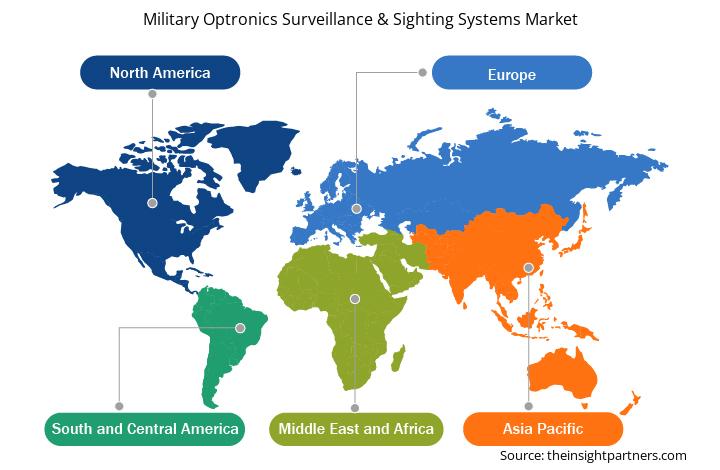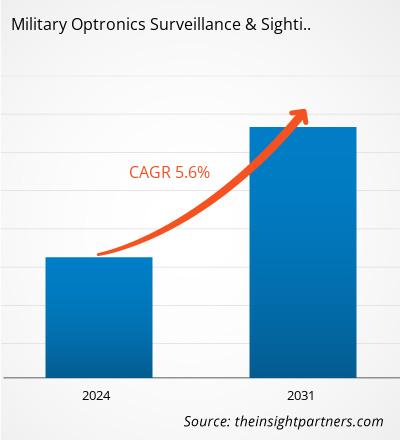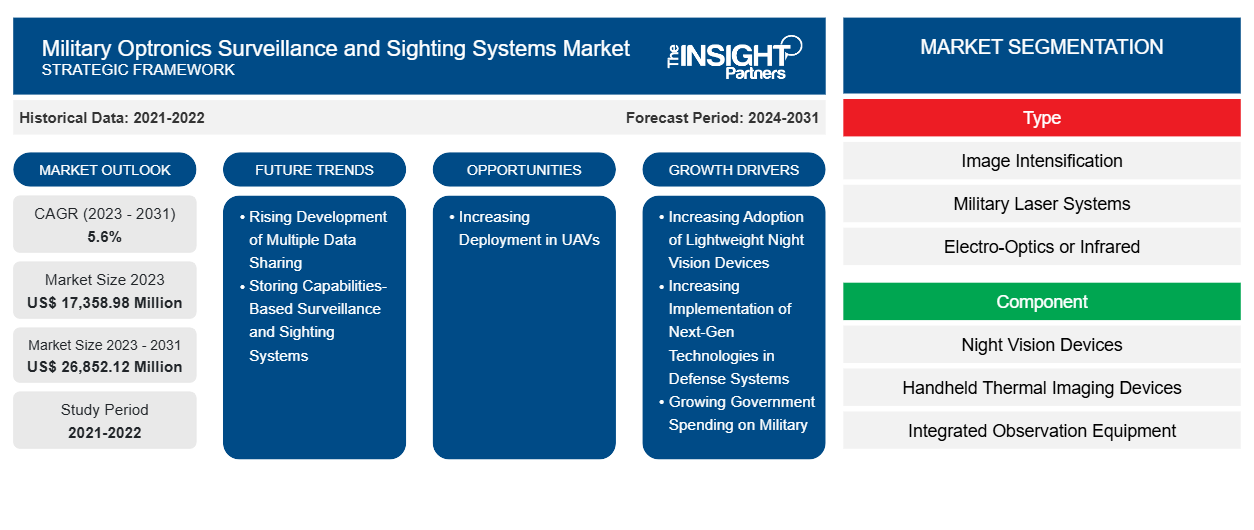Der Markt für militärische optronische Überwachungs- und Zielsysteme soll von 17.358,98 Millionen US-Dollar im Jahr 2023 auf 26.852,12 Millionen US-Dollar im Jahr 2031 anwachsen. Der Markt soll zwischen 2023 und 2031 eine durchschnittliche jährliche Wachstumsrate (CAGR) von 5,6 % verzeichnen. Die zunehmende Entwicklung von Überwachungs- und Zielsystemen mit mehreren Datenaustausch- und -speicherfunktionen dürfte in den kommenden Jahren neue wichtige Trends auf dem Markt mit sich bringen.
Marktanalyse für militärische optronische Überwachungs- und Zielsysteme
Mit der zunehmenden Innovation und der steigenden Bedrohung durch Terroranschläge in der Nacht steigt die Nutzung von Nachtsichtgeräten. Ebenso hilft die Wärmebildgebung Soldaten, ein Ziel bei schlechten Sichtverhältnissen zu lokalisieren. Wärmebild-Nachtsichtgeräte werden weltweit immer beliebter, um die Systeme einzelner Soldaten zu stärken. Nachtsichtgeräte bieten Soldaten ein besseres Situationsbewusstsein, indem sie ihre Umgebung bei nächtlichen Einsätzen beleuchten. Zunehmende Regierungsinitiativen zur Entwicklung und Einführung von leichten Nachtsichtgeräten auf Basis fortschrittlicher Technologien haben eine enorme Nachfrage nach dem Wachstum des Marktes für militärische optronische Überwachungs- und Zielsysteme geschaffen. So wählte die Defence Advanced Research Projects Agency (DARPA) des US-Verteidigungsministeriums im Januar 2022 10 Verteidigungs- und Universitätsforschungsteams für die Entwicklung von leichten Nachtsichtoptiken für Militärsoldaten in Amerika aus. Die Abteilung entwickelte das Programm Enhanced Night Vision in Eyeglass Form (ENVision), um die neue Technologie zur Entwicklung von Nachtsichtsystemen zu übernehmen.
Der zunehmende Einsatz von UAVs auf der ganzen Welt zum Schutz von Gebieten vor Nachbarländern dürfte im Prognosezeitraum reichlich Gelegenheit für das Wachstum des Marktes für optoelektronische Überwachungs- und Zielsysteme schaffen . So setzte die indische Armee im Jahr 2022 die erste Charge von mehr als 25 in Israel hergestellten UAVs mit dem Namen Searcher Mark II ein. Darüber hinaus begann die US-Regierung im Mai 2024 im Rahmen ihres Regierungsprogramms zur Bekämpfung der chinesischen Verteidigungsfähigkeiten mit der Lieferung von UAVs an ihr Militär. Im März 2023 entwickelten Wissenschaftler in China eine Militärdrohne, die sich in der Luft schnell in sechs separate Einheiten aufspalten kann. Diese Drohnen werden mit Luftzerlegungstechnologien hergestellt. Diese zunehmenden Investitionen und Einsätze von UAVs durch die Regierungen mehrerer Länder dürften im Prognosezeitraum reichlich Gelegenheiten für den Markt für optoelektronische Überwachungs- und Zielsysteme schaffen.
Marktübersicht für militärische optronische Überwachungs- und Zielsysteme
Militärische Optronik-, Überwachungs- und Zielsysteme statten das Personal mit ausreichenden Werkzeugen aus, um Bedrohungen in Luft-, Land- und Seekriegsumgebungen zu identifizieren, zu verfolgen, zu überwachen und zu bekämpfen. Diese Systeme bieten den Streitkräften präzise Erkennung, Erkennung und Identifizierung von Zielen und Situationsbewusstsein durch die Integration von Hochleistungsoptikkomponenten und fortschrittlichen Sensoren. Darüber hinaus finden die Optronik-, Überwachungs- und Zielsysteme Anwendung, um die Anforderungen von Grenzkontroll-, Basisschutz-, Aufklärungs- und Informationsbeschaffungsmissionen zu erfüllen. Technologische Fortschritte in der Optronik und Überwachungssystemen sowie die anhaltende Nachfrage der Verteidigungskräfte nach Modernisierung ihrer vorhandenen Ausrüstung und Systeme treiben den globalen Markt für militärische Optronik-, Überwachungs- und Zielsysteme an.
Passen Sie diesen Bericht Ihren Anforderungen an
Sie erhalten kostenlose Anpassungen an jedem Bericht, einschließlich Teilen dieses Berichts oder einer Analyse auf Länderebene, eines Excel-Datenpakets sowie tolle Angebote und Rabatte für Start-ups und Universitäten.
-
Holen Sie sich die wichtigsten Markttrends aus diesem Bericht.Dieses KOSTENLOSE Beispiel umfasst eine Datenanalyse von Markttrends bis hin zu Schätzungen und Prognosen.
Treiber und Chancen für den Markt für militärische optronische Überwachungs- und Zielsysteme
Zunehmende Nutzung leichter Nachtsichtgeräte
Mit zunehmender Innovation und steigender Bedrohung durch Terroranschläge in der Nacht steigt die Nutzung von Nachtsichtgeräten. Früher verwendeten Nachtsichtgeräte relativ schwere Komponenten, was das Gewicht eines Soldaten erhöhte. Verschiedene Marktteilnehmer führen jetzt leichte Nachtsichtprodukte ein. Beispielsweise hat ACTinBlack ein leichtes binokulares Nachtsichtgerät mit hoher optischer Leistung und ergonomischem Design entwickelt. Im Oktober 2023 brachte Thermoteknix Systems, ein in den USA ansässiges Unternehmen für Wärmebildgebung und Augmented Reality (AR), eine Nachtsichtlösung namens Fused Night Vision Goggle mit fortschrittlicher Augmented Reality (FNVG-AR) auf den Markt. Das FNVG-AR-System ist eine leichte binokulare Nachtsichtbrille (NVG), die mit fortschrittlicher Technologie basierenden 16-mm-Weißphosphor-Nachtsichtröhren der nächsten Generation und einer hochauflösenden Wärmebildkamera ausgestattet ist.
Zunehmender Einsatz in UAVs
Unbemannte Systeme sind zu einem integralen Bestandteil der Streitkräfte weltweit geworden, da sie das Risiko für Menschenleben verringern. Aufgrund der verschiedenen Vorteile, die unbemannte Luftfahrzeuge (UAVs) bieten, haben viele Länder wie die USA, Indien und China beträchtliche Budgets bereitgestellt, um mehr UAVs in ihren Streitkräften einzusetzen, hauptsächlich für Überwachungsanwendungen. Der Einsatz optronischer Überwachungs- und Zielsysteme auf unbemannten Plattformen erleichtert die Übertragung von Überwachungs- und Bilddaten. Die Integration unbemannter Systeme mit Kommunikationsantennen und anderen Überwachungsgeräten hilft bei verschiedenen kritischen Missionen. Daher führt der zunehmende Einsatz von UAVs für Luft- und Seeüberwachungs- und Kartierungsmissionen zu einem wachsenden Bedarf an optronischen Überwachungs- und Zielsystemen, die effektiv in die UAV-Plattform integriert werden können, ohne deren Gesamteffizienz zu beeinträchtigen. Daher legen mehrere große Branchenakteure, darunter Rafael Advanced Defense Systems Ltd. und Lockheed Martin, auf dem Markt für militärische optronische Überwachungs- und Zielsysteme Wert auf die Entwicklung und das Angebot optronischer Überwachungs- und Zielsysteme für UAV-Plattformen.
Segmentierungsanalyse des Marktberichts zu militärischen optronischen Überwachungs- und Zielsystemen
Wichtige Segmente, die zur Ableitung der Marktanalyse für militärische optronische Überwachungs- und Zielsysteme beigetragen haben, sindTyp, Komponente und Endbenutzer.
- Basierend auf dem Typ wird der Markt für militärische optronische Überwachungs- und Zielsysteme in Bildverstärkung, militärische Lasersysteme und Elektrooptik/Infrarot unterteilt. Das Segment Elektrooptik hatte im Jahr 2023 den größten Marktanteil.
- Nach Komponenten wird der Markt in Nachtsichtgeräte, tragbare Wärmebildgeräte, integrierte Beobachtungsgeräte, eigenständige Infrarot-, seismische und akustische Sensoren und andere unterteilt. Das Segment der seismischen und akustischen Sensoren dominierte den Markt im Jahr 2023.
- In Bezug auf die Endnutzer wird der Markt für militärische optronische Überwachungs- und Zielsysteme in Boden-, Luft- und Marinesysteme unterteilt. Das Bodensegment hielt im Jahr 2023 den größten Marktanteil.
Militärische optronische Überwachungs- und Zielsysteme Marktanteilsanalyse
Der geografische Umfang des Marktberichts für militärische optronische Überwachungs- und Zielsysteme bietet eine detaillierte globale Analyse. Nordamerika, Europa und der asiatisch-pazifische Raum sind wichtige Regionen, in denen der Markt für militärische optronische Überwachungs- und Zielsysteme ein signifikantes Wachstum verzeichnet. Der Markt für militärische optronische Überwachungs- und Zielsysteme in Nordamerika ist weiter in die USA, Kanada und Mexiko unterteilt. Im Jahr 2023 dominierten die USA den Markt für militärische optronische Überwachungs- und Zielsysteme in Nordamerika mit einem signifikanten Marktanteil im Jahr 2023, gefolgt von Kanada und Mexiko. Diese entwickelten Volkswirtschaften geben einen beträchtlichen Teil ihres BIP für Militärausgaben aus. Laut der Sammlung von Entwicklungsindikatoren der Weltbank, die aus offiziell anerkannten Quellen zusammengestellt wurden, betrugen die Militärausgaben in den USA im Jahr 2023 etwa 3,5 % ihres BIP. Außerdem gab die US-Regierung im Haushaltsjahr 2023 nach Angaben des US-Haushaltsministeriums 820 Milliarden US-Dollar für den nationalen Verteidigungssektor aus. Der Betrag wurde auf 13 % der US-Bundesausgaben geschätzt. Die wichtigsten Akteure auf dem Markt entwickeln fortschrittliche Technologien auf der Grundlage von luftgestützten optronischen Überwachungssystemen, fortschrittlichen digitalen Wärmebildkameras, Verfolgungs- und Suchsystemen und mehr. So brachte beispielsweise das US-amerikanische Unternehmen Obsidian Sensors Inc. im Jahr 2023 eine neue Technologie auf den Markt, die Wärmebilder mit erschwinglichen hochauflösenden Sensoren verarbeitet.
Regionale Einblicke in den Markt für militärische optronische Überwachungs- und Zielsysteme
Die regionalen Trends und Faktoren, die den Markt für militärische optronische Überwachungs- und Zielsysteme während des Prognosezeitraums beeinflussen, wurden von den Analysten von Insight Partners ausführlich erläutert. In diesem Abschnitt werden auch die Marktsegmente und die Geografie für militärische optronische Überwachungs- und Zielsysteme in Nordamerika, Europa, im asiatisch-pazifischen Raum, im Nahen Osten und Afrika sowie in Süd- und Mittelamerika erörtert.

- Erhalten Sie regionale Daten zum Markt für militärische optronische Überwachungs- und Zielsysteme
Umfang des Marktberichts zu militärischen optronischen Überwachungs- und Zielsystemen
| Berichtsattribut | Details |
|---|---|
| Marktgröße im Jahr 2023 | 17.358,98 Millionen US-Dollar |
| Marktgröße bis 2031 | 26.852,12 Millionen US-Dollar |
| Globale CAGR (2023 - 2031) | 5,6 % |
| Historische Daten | 2021-2022 |
| Prognosezeitraum | 2024–2031 |
| Abgedeckte Segmente |
Nach Typ
|
| Abgedeckte Regionen und Länder |
Nordamerika
|
| Marktführer und wichtige Unternehmensprofile |
|
Dichte der Marktteilnehmer für militärische optronische Überwachungs- und Zielsysteme: Auswirkungen auf die Geschäftsdynamik verstehen
Der Markt für militärische optronische Überwachungs- und Zielsysteme wächst rasant, angetrieben von der steigenden Nachfrage der Endnutzer aufgrund von Faktoren wie sich entwickelnden Verbraucherpräferenzen, technologischen Fortschritten und einem größeren Bewusstsein für die Vorteile des Produkts. Mit steigender Nachfrage erweitern Unternehmen ihr Angebot, entwickeln Innovationen, um die Bedürfnisse der Verbraucher zu erfüllen, und nutzen neue Trends, was das Marktwachstum weiter ankurbelt.
Die Marktteilnehmerdichte bezieht sich auf die Verteilung der Firmen oder Unternehmen, die in einem bestimmten Markt oder einer bestimmten Branche tätig sind. Sie gibt an, wie viele Wettbewerber (Marktteilnehmer) in einem bestimmten Marktraum im Verhältnis zu seiner Größe oder seinem gesamten Marktwert präsent sind.
Die wichtigsten Unternehmen auf dem Markt für militärische optronische Überwachungs- und Zielsysteme sind:
- Airbus
- Lockheed Martin Corporation
- Thales-Gruppe
- General Dynamics Corporation
- L3Harris Technologies Inc.
- Israelische Luft- und Raumfahrtindustrie
Haftungsausschluss : Die oben aufgeführten Unternehmen sind nicht in einer bestimmten Reihenfolge aufgeführt.

- Erhalten Sie einen Überblick über die wichtigsten Akteure auf dem Markt für militärische optronische Überwachungs- und Zielsysteme
Nachrichten und aktuelle Entwicklungen zum Markt für militärische optronische Überwachungs- und Zielsysteme
Der Markt für militärische optronische Überwachungs- und Zielsysteme wird durch die Erhebung qualitativer und quantitativer Daten nach Primär- und Sekundärforschung bewertet, die wichtige Unternehmensveröffentlichungen, Verbandsdaten und Datenbanken umfasst. Nachfolgend sind einige der Entwicklungen auf dem Markt für militärische optronische Überwachungs- und Zielsysteme aufgeführt:
- Der Sensorspezialist HENSOLDT liefert eine nicht näher benannte Anzahl hochmoderner optischer Sichtsysteme für den Schützenpanzer PUMA. Auftraggeber sind die Systemhäuser KNDS und Rheinmetall, die den Schützenpanzer PUMA produzieren und über die gemeinsam gegründete PSM GmbH vertreiben. Der Auftragswert liegt im zweistelligen Millionenbereich. Der Auftrag umfasst neben Sichtsystemen für Türme von Schützenpanzern auch die Ausstattung von zwölf Turmtrainern zur Ausbildung von Fahrzeugbesatzungen. Mit dieser Lieferung trägt HENSOLDT zur Verbesserung des PUMA auf dem K-Stand S1 bei. (Quelle: HENSOLDT, Pressemitteilung, Juni 2024)
- Die französischen Streitkräfte haben die ersten 300 Thales-Nachtsichtgeräte erhalten, die die französische Verteidigungsbeschaffungsbehörde (DGA) im Jahr 2020 im Rahmen des Bi-NYX-Vertrags bestellt hatte. Die 300 an die DGA gelieferten Geräte sind die erste Charge einer Bestellung von 2.000 Geräten, die im Dezember 2023 aufgegeben wurde. Die restlichen 1.700 Geräte werden bis Ende dieses Jahres ausgeliefert. (Quelle: Thales, Pressemitteilung, Oktober 2024)
Marktbericht zu optronischen Überwachungs- und Zielsystemen für das Militär – Umfang und Ergebnisse
Der Bericht „Marktgröße und Prognose für militärische optronische Überwachungs- und Zielsysteme (2021–2031)“ bietet eine detaillierte Analyse des Marktes, die Folgendes abdeckt:
- Marktgröße und Prognose für militärische optronische Überwachungs- und Zielsysteme auf Länderebene für alle wichtigen Marktsegmente, die im Rahmen des Projekts abgedeckt sind
- Markttrends für militärische optronische Überwachungs- und Zielsysteme sowie Marktdynamiken wie Treiber, Einschränkungen und wichtige Chancen
- Detaillierte PEST- und SWOT-Analyse
- Marktanalyse für militärische optronische Überwachungs- und Zielsysteme mit Blick auf wichtige Markttrends, Länderrahmen, wichtige Akteure, Vorschriften und aktuelle Marktentwicklungen
- Branchenlandschaft und Wettbewerbsanalyse, die die Marktkonzentration, Heatmap-Analyse, prominente Akteure und aktuelle Entwicklungen auf dem Markt für militärische optronische Überwachungs- und Zielsysteme umfasst
- Detaillierte Firmenprofile
- Historische Analyse (2 Jahre), Basisjahr, Prognose (7 Jahre) mit CAGR
- PEST- und SWOT-Analyse
- Marktgröße Wert/Volumen – Global, Regional, Land
- Branchen- und Wettbewerbslandschaft
- Excel-Datensatz
Aktuelle Berichte
Verwandte Berichte
Erfahrungsberichte
Grund zum Kauf
- Fundierte Entscheidungsfindung
- Marktdynamik verstehen
- Wettbewerbsanalyse
- Kundeneinblicke
- Marktprognosen
- Risikominimierung
- Strategische Planung
- Investitionsbegründung
- Identifizierung neuer Märkte
- Verbesserung von Marketingstrategien
- Steigerung der Betriebseffizienz
- Anpassung an regulatorische Trends























 Kostenlose Probe anfordern für - Markt für militärische optronische Überwachungs- und Zielsysteme
Kostenlose Probe anfordern für - Markt für militärische optronische Überwachungs- und Zielsysteme